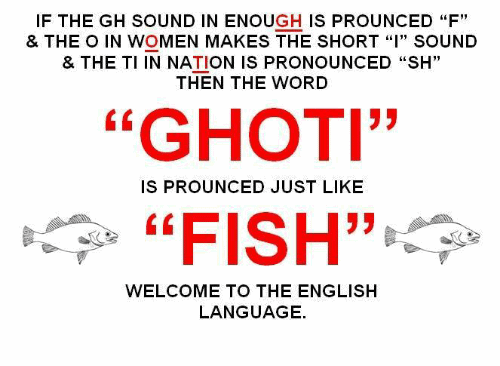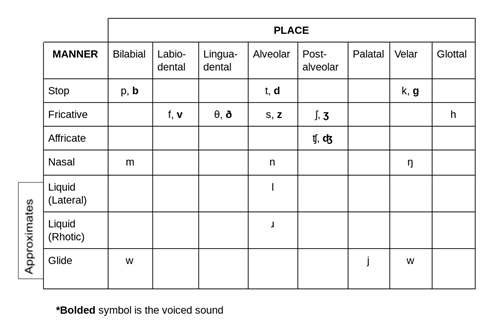What is the International Phonetic Alphabet?
The International Phonetic Alphabet, or IPA, is a notation system that uses symbols to represent the sounds of spoken language. Each symbol corresponds to a distinct sound, and as long as you know the symbol-to-sound correspondence, you should be able to pronounce any word you encounter.
For example, the “eee” sound is represented by the /i/ symbol in the IPA. Any time you see the /i/ symbol transcribed in a word, then you’ll know that you pronounce that sound as “eee”. So in the words he, tea, and me, you should pronounce the vowel sound as “eee”:
he: /hi/ tea: /ti/ me: /mi/
The IPA is incredibly helpful when learning how to speak a foreign language, and especially for those languages that are not phonetic, like English. This means that in English, you can’t rely on the spelling of the word to let you know how you should pronounce it - the letters don’t always correspond to the same sound.
English is Not a Phonetic Language
Let’s take the classic example of the words through, cough, and bough. All three words contain the “ough” spelling, but they are each pronounced differently. If you’ve never seen these words before, you may have no idea how to pronounce them, and you’d have to rely on another system to help you with pronunciation. That’s where the IPA comes in handy!
Here are the IPA transcriptions of these words (and listen to my recording to hear how to I say them):
Through: /θru/. The “ough” spelling makes an “uuu” sound.
Cough: /kɑf/. The “ough” spelling makes an “ah” sound.
Bough: /ba͡ʊ/. The “ough” spelling makes an “ow” sound.

American English speakers also have difficulty with pronouncing (and spelling) unfamiliar words for this same reason. And where do they turn for help? The IPA and a dictionary!
American English IPA Chart - Consonants
So if you’re not already familiar with the IPA, hopefully this blog will convince you that you should be! It will make a huge difference in your ability to correctly pronounce any word you encounter (I promise!)
Here’s a simplified version of the IPA that shows the consonants of American English (click here for my blog about the American English vowels):

You'll notice the chart is arranged based on these three parameters: Place, Manner, and the bolded symbols that show Voicing. In order to fully understand how to pronounce the sounds of American English using the IPA chart, it will be helpful for you to also learn what those three parameters mean.
Place of Articulation
Place refers to the place in the mouth where the sound is made. So a sound that is a bilabial, like /p/, is made with both of the lips (bi = both, labial = lips). Watch yourself in the mirror when you say the word “please”, and you’ll notice that your lips come together when you pronounce the /p/ sound.
Here are the Places of articulation:
Bilabial: Both lips (bi = both, labial = lips)
Labio-dental: Lips and teeth (Labio = lips, dental = teeth)
Lingua-dental: Tongue and teeth (Lingua = tongue, dental = teeth)
Alveolar: Tip of the tongue is touching the gum ridge behind your front teeth (this is called the Alveolar Ridge)
Post-alveolar: Tongue is touching behind the alveolar ridge (post = behind)
Palatal: Middle part of tongue up against the middle portion of the roof of the mouth
Velar: Back part of the tongue is touching the back portion of the roof of the mouth (also called the soft palate)
Glottal: Made at the vocal cords
Manner of Production
The Manner of production refers to the way the air is released for that sound. For example, the /p/ sound is called a Stop - this means the airflow is stopped somewhere when the sound is made. Since we know the place of the /p/ sound is with both lips, it is here that the airflow is stopped - at the closure of the lips.
Here are the Manners of production:
Stop: The airflow is stopped so that airflow ceases for a brief amount of time
Fricative: The airflow is pushed through a small opening, which creates turbulence to the airflow
Affricate: Begins as a stop (airflow ceases) and releases as a fricative (airflow is pushed through a small opening)
Nasal: Air escapes through the nose (air does not come out the mouth because there is complete closure somewhere within the mouth)
Approximate: Articulators approach each other but not narrowly enough to create turbulent airflow (as is seen with fricatives and affricates)
Liquids: Tongue produces a partial closure in the mouth, and the air flows around that partial closure (air flows out the center of the tongue for /ɹ/, and out the sides of the tongue for /l/).
Glides: Continued, gliding motion of the articulators into the following vowel; sometimes also called semi-vowels
Voicing
And lastly, we have voicing. Voicing refers to the vibration of your vocal cords - voiced means the vocal cords are vibrating, and voiceless means the vocal cords are not vibrating.
To understand the concept of vocal cord vibration, try this quick exercise. Place your hand on your throat and breathe. What do you feel? You should feel...nothing. While you’re breathing, your vocal cords are wide open, and air is just passing through unobstructed. Now keeping your hand on your throat, say the word he and hold out the first sound “hhhhh”. You should feel no vibration of your vocal cords - just the air is moving. This is the voiceless “h” sound, or /h/.
Now say the word he again, and as you keep your hand on your throat, hold out the vowel sound “eee” (/i/ in IPA). What do you feel this time? You should feel vibration or movement of your vocal cords. When a sound is made with the vocal cords vibrating, we call it a voiced sound. The word he has both a voiceless /h/ sound and a voiced /i/ sound.
Additional Practice
Here are the consonants of American English listed by the IPA symbol and a target word. Listen to my recording below to hear me pronounce each of the words. And click here for a FREE, printable version of the American English Consonants.
/p/ pop
/b/ boy
/t/ too
/d/ dog
/k/ cat
/g/ go
/f/ fish
/v/ of
/θ/ think
/ð/ this
/s/ same
/z/ zipper
/ʃ/ shoe
/ʒ/ pleasure
/h/ hello
/ʧ/ chair
/ʤ/ July
/m/ mom
/n/ never
/ŋ/ sing
/l/ life
/ɹ/ red
/w/ water
/j/ you
Thanks for watching! And I'd love to hear from you - contact me to learn how we can work together to perfect your American English pronunciation!
******************************************************************************************************
Interested in more American English pronunciation practice? Be sure to check out some of my most popular online resources (all free!):
- Dark L and Light L exercises: Free, downloadable and printable pdf
- Semi-Occluded Vocal Tract (SOVT) exercises: Free, downloadable and printable pdf
- Stressed and Unstressed Syllables exercises: Free, downloadable and printable pdf
- AH /ɑ/ and UH /ʌ/ Vowel pronunciation exercises: Free, downloadable and printable pdf
- American R /ɹ/ Consonant pronunciation exercises: Free, downloadable and printable pdf
- Vowel to Vowel Linking exercises: Free, downloadable and printable pdf
- Consonant to Vowel Linking exercises: Free, downloadable and printable pdf
- Word Reductions and English Rhythm exercises: Free, downloadable and printable pdf
- N /n/ and NG /ŋ/ Consonant pronunciation exercises: Free, downloadable and printable pdf
- Respiratory and Breath Support exercises: Free, downloadable and printable pdf
- International Phonetic Alphabet (IPA) for English Vowels: Free, downloadable and printable pdf
- International Phonetic Alphabet (IPA) for English Consonants: Free, downloadable and printable pdf
- Resonatory and Vocal Projection exercises: Free, downloadable and printable pdf
- Articulatory and Tongue Twister exercises: Free, downloadable and printable pdf
- Glottal Stop T /ʔ/, Flap T /ɾ/, and True T /t/ exercises: Free, downloadable and printable pdf
- EE /i/ and IH /ɪ/ Vowel pronunciation exercises: Free, downloadable and printable pdf
- Presentation Skills Training exercises: Free, downloadable and printable pdf
- Sentence-level Stress and Content Word Stress exercises: Free, downloadable and printable pdf


